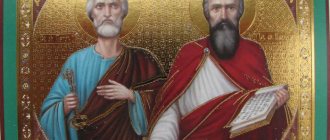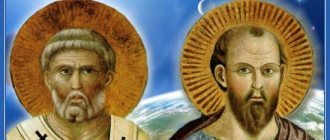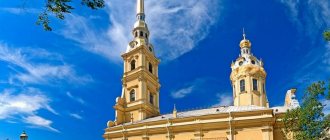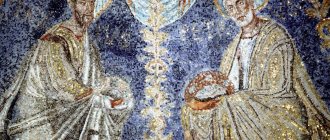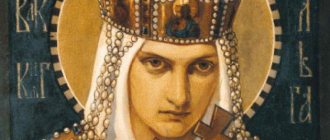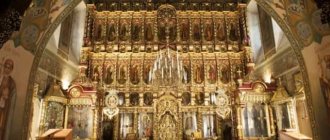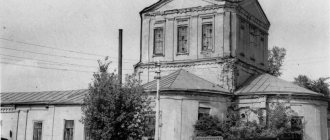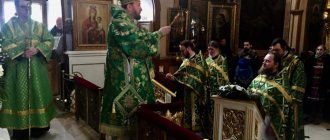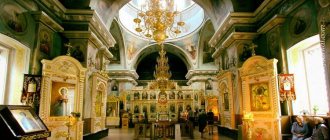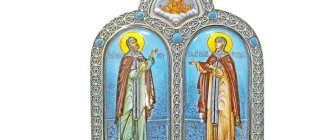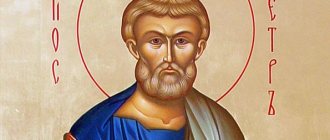Christian iconography knows many variations in the image of the venerable saints. The first images are found during the birth of this divine art. The Apostles, faithful disciples of the Savior, were more often represented in scenes from the Gospel on tomb reliefs or on frescoes. The icons of Saints Peter and Paul mercifully provide assistance to repentant atheists, Orthodox Christians who have lost their faith, as well as those who came to Christianity from another religion. They support people in undertaking noble deeds.
Canonical image
The Holy Apostle Peter is depicted in the icon as a wise old man with a short beard, sometimes with curly hair. His outer clothes are always golden in color, his under clothes are dark blue or blue-green. With his right hand he blesses or holds the keys of the Kingdom of Heaven. In his left hand he holds a scroll with the text or gospel words: “You are the Christ, the son of the living God” (Matthew 16: 16).
The Holy Apostle Paul on the icon is depicted with a high forehead, slightly bald, with dark hair, and a wide beard. He usually holds a scroll, sometimes as a single book or as 14 rolls tied together. His outer clothing is brown or dark purple, and his chiton is light, blue or blue-green.
The end of life's journey
Most of the apostles ended their lives tragically. The fact is that in those distant times Christianity was only a small sect. The rulers considered the followers of the new religion dangerous and felt a threat to power. Therefore, they tried to destroy everyone who considered Christ God and baptized people into their faith.
For example, Peter, already in old age, was taken into custody and executed by crucifixion, like Christ. Only true faith can withstand such a severe test. The apostle asked his executioners to turn him upside down, so as not to become like his Teacher. After all, after his famous renunciation, he felt unworthy to die in the same way as the Teacher.
Paul also faced a painful death - but he was formally a citizen of Rome, even though he was a Jew by birth. Therefore, a more “honorable” execution was applied to him - beheading. After all, only people of the lower class, robbers, and vagabonds were crucified.
Church tradition claims that the apostles were killed on one day. Paul was taken out of the city - on the site of his death, Tsar Constantine erected a temple. Scientists have confirmed that the relics at its base belong to a noble Roman citizen.
How does the icon of Peter and Paul help?
In front of the apostles Peter and Paul on the icon they pray mostly for matters related to faith, because they were active disseminators and preachers of Christianity. Even now they can help ordinary people strengthen their faith and become more righteous. The prayer can be performed to each saint separately or to two at once; if you turn to one person, there is nothing terrible in this; it is even possible to more competently differentiate prayers depending on the goal.
If the emphasis is on the image of Peter in the icon and prayer to this apostle, then he is often approached with requests to be confirmed in the faith, and also fishermen who are assisted by the saint turn to him. In turn, Saint Paul on the icon serves as an image to which people turn in order to receive blessings and help in their studies. After all, Pavel was a deeply educated person and is secretly considered an assistant in various matters related to study and education.
As such, the icon of Peter and Paul is considered miraculous and can grant healing. Sincere faith can do miracles, which is why you should not limit yourself too strictly. It is permissible to ask an icon for almost anything within the framework of the Orthodox faith.
Spirituality at the heart of the image of the apostles
Nowadays, in the iconostases of most churches, an integral part of the Deesis row is the icon of Peter and Paul.
Its significance has increased immeasurably over time. The reason lies in a more complete understanding of their images. They are symbols of boundless faith in the truth of Christ’s teaching, which allows even a simple, unlearned and weak person, as Peter was before, to rise to the heights of holiness. In addition, this is a symbol of the openness of the path to spiritual perfection for those who initially not only did not accept the teachings of Christians, but were also their furious persecutors, like the Apostle Peter. Of course, in our post-atheistic times, such images are very relevant, especially since the Orthodox Church is conducting extensive educational work aimed at filling those gaps in the religious education of the people that arose during the era of theomachism. In general, any depiction of the apostles is a visual preaching of the Christian faith, opening the gates to eternal life.
History of the Saints
The story of each of these saints is a unique story of faith and devotion to Christ. They had completely different paths to faith, but at the same time they eventually became one of the most revered saints. As a rule, there is an icon of the apostles Peter and Paul in almost every church.
Peter was a fisherman for many years and met Christ while he was engaged, so to speak, in his own professional activity. He became a follower of the Savior and eventually became one of the twelve apostles, and after the Resurrection he preached in different countries.
Paul, in turn, for many years was an opponent of Christ and blasphemed his faith. However, after the Savior miraculously appeared to him, Paul believed and became an apostle. Although he is not one of the 12 or 70 apostles, he is considered the supreme apostle - this is his special title.
As a result, each of them was executed in Rome on the same day in 67. That is why the apostles Peter and Paul are often depicted on icons in each other’s arms. They cling to their cheeks in the same way as Christ clings to his own Mother on the Tenderness icon, where the soul’s desire for the spiritual world is thus symbolized, and not just the relationship between an adult and a child.
The apostles, in turn, symbolize the unity of people in the church and the unifying faith
They also symbolize opposing characters, because Peter was essentially a simpleton who sincerely believed, and Paul was an educated man, and he believed with all the power of his mind. This is the meaning of the icon of Peter and Paul, and if you look at how such an image helps, then you need to note the help of the holy image in the ability to guide another person on the true path.
If someone close to you has deviated from the faith and gone astray (in a metaphorical sense), you should turn to this image, which can help you unite with another person on the basis of a common faith.
Church Icon
On the one hand, the apostle to the pagans, on the other, the apostle to the Jews. Here is a learned man who spent decades studying Jewish and Hellenic wisdom, here is a fisherman, a simple and religious man, enlightened by the Holy Spirit. Two very different people, but both are disciples of Christ and miracle workers. Peter's shadow heals the sick, Paul's headscarves ward off illnesses. They prophesy, disciple, ordain, and tirelessly share the gospel message. And at the same time, they don’t understand each other! Peter Finds Something Puzzling
(2 Pet. 3:16).
Of course, there is controversy surrounding the texts of the apostles. Researchers sift through ancient manuscripts letter by letter, regularly making sensational claims about the authenticity of the texts, about authorship, or about literary influences.
This is all important and necessary. But for me, no less important is the revelation that the icon of the apostles brings, because it is an icon of the Church
What can you talk about with a person who has not read Schmemann?
How can you pray next to a citizen who keeps Schmemann’s books at home?
My monastic opponent almost started a civil war when he learned that I was giving Lewis's books to read.
- Seduces the brethren with a Protestant heretic!
You will say that this is very far from Peter and Paul? Not at all. This was our little “chagrin”. Here we have in no way surpassed the apostolic age. And there is no need to be offended. And don’t rush to curse. It is not a pity to spend years and dozens of hours of conversations and prayers in order to gain your brother, who is also a child of God, and our own fatherly home has been prepared for both of us.
The Church is the justification for diversity. There have always been and will be people who are disgusted by this diversity of life and opinions. Even ancient philosophers suspected some kind of disorder and a challenge to their sterile thinking in the diversity of existence. We are very different, and that's good. Church diversity is a real test for a believer. It is natural for us to look for harmonious and understandable schemes, clear formulas that cut off everything unnecessary from the Church, but very often these are just human standards.
Church diversity is not simply a matter of tolerance and good education. The Apostles Peter and Paul look at us from the icon. Two very different people lived by Christ and only by Christ and lived this life of Christ in very different ways, sometimes even making mistakes, sometimes not understanding each other. Despite all their dissimilarity, these were incredibly close people, because their unity was unity in Christ. Not in a political program, not in cultural predilections, not in philosophical systems, not in the rhythm of piety or liturgical practice. They lived by Christ, and this is precisely what we must proceed from when we meet people in the Church who are so provocatively different. If he lives by Christ, he is my brother, no matter who he votes for in the elections.
If there were upsets among the “most holy saints,” what can we say about us? We also quarrel, swear, and suspect. But look around - you will while away eternity with these people! What if you and your “sworn friend” end up sharing the same icon?
The Church is a community of dissimilar people. It happens that we are not able to find a common language with a brother in Christ, but we are together in one Church, under one head Christ, at the same Chalice of the Lord, and in eternity - on the same icon of the Church Triumphant.
Prayers before the icon of the apostles Peter and Paul
O glorification of the apostles Peter and Paul, who gave up their souls for Christ and fertilized His pasture with your blood! Hear your children's prayers and sighs, now offered by your brokenhearted hearts. Because we are darkened by lawlessness and for this reason we are covered with troubles, like clouds, but with the oil of a good life we are greatly impoverished and we are not able to resist the predatory wolf who is boldly trying to plunder the heritage of God. O strength! Bear our infirmities, do not separate from us in spirit, so that we may not be separated in the end from the love of God, but protect us with your strong intercession, may the Lord have mercy on us all, for your prayers for the sake of your prayers, may He destroy the handwriting of our immeasurable sins and may He be honored with all the saints of the blessed The Kingdom and Marriage of His Lamb, to Him be honor and glory, and thanksgiving and worship, forever and ever. Amen.
( 3 ratings, average: 4.33 out of 5)
Troparion, kontakion, magnification
Troparion, tone 4:
The Apostles of the first throne, / and the universal teachers, / pray to the Lord of all, / to grant universal peace, // and great mercy to our souls.
Kontakion, voice 2:
Firm and divinely preached preachers,/ the top of your apostles, Lord,/ you accepted for the enjoyment of your good things and peace:/ you accepted illness and death more than all fruitfulness,// One, dear heart.
Greatness
We magnify you, / Christ’s apostles Peter and Paul, / who enlightened the whole world with your teachings // and brought everything to Christ.
Veneration in temples
In Orthodoxy, there is a special church holiday, which is preceded by summer fasting - the day of the apostles Peter and Paul. Therefore, the saints can often be seen together on the icon, since both of them did a lot for the formation of the Church of Christ. What can you pray for before doing this? The request can be anything, but there are some traditions.
- Both help those who want to gain faith and facilitate the assimilation of the Word of God.
- St. Paul patronizes students and heals those who suffer from spiritual and mental illnesses. During his lifetime, he resurrected the dead. He will also take care of those who start their own business, if it is useful to others - after all, the apostle was known for working hard.
- St. Peter helps those who suffer from fever or other physical ailment. He is the patron saint of sailors and fishermen.
We advise you to study Psalm of David 76 in Russian and Church Slavonic.
You can pray briefly, or read an akathist - it depends on the disposition of your soul
It is important that the person praying understands that the Lord fulfills only those desires that are pleasing to His will. After all, saints cannot contradict the Creator, they are spiritual mentors of believers
The power to perform miracles was given to them as a reward from God for faith and work on themselves.
Iconography
The first images of the Apostle Peter appeared in the Roman catacombs, where early Christians gathered for their services and Peter himself could have visited. The characteristic features that distinguish the images of Peter in icons and paintings of later times are already visible there: a small gray beard, short, also gray hair.
One of the earliest canonical icons of the Apostle Peter is located in the Sinai Monastery of St. Catherine, and dates back to the 4th century. This icon is made using the encaustic technique, i.e., painted with hot wax paints.
In the icon you can see a gray-haired man with a short beard, with a very attentive, thoughtful look and general facial expression. The Apostle holds the scrolls as a sign of his service in spreading the faith of Christ and the cross, as a symbol of the fact that he was faithful to the word of the Lord until the end of his life and carried out the confession of his faith to the end. A very similar image of the Apostle Peter can be seen in the Basilica of San Vitale in Ravenna.
Apostle Petrvi V.Frühe Ikonen 1972: VII V. Ochcherki of the History of Art 1987: VI V.βοτοτοτοivers 1995: The second half of the VI - the beginning of the VII centuries Bayet 2009: VI V. Khgolek 2009: VI V. Encautical icon92.8 × 53.1 SM cm.
In early Christian times, constant attributes appeared in the form of a scroll and keys, as a sign that Peter was the gatekeeper of Paradise. This is how Peter appears already in the very first ancient Russian icons. These include the 11th century Novgorod icon of Peter and Paul, presumably brought by Prince Vladimir from Korsun.
Apostles Peter and PaulSchool or art. center: Novgorod Mid-XI century. Painting of pre-Mongol Rus' 1974: Mid-XI century. Lazarev 2000/1: Mid-XI century. Vilinbakhova 2006: Mid-XI century. Icons of Veliky Novgorod 2008: Approx. 1050–1052 Trifonova 2013: Middle - second half of the 11th century. 236 × 147 cm Novgorod State. Historical-Architectural and Art Museum-Reserve, Novgorod, RussiaInv. 11776
Another icon of the pre-Mongol period, depicting the apostles Peter and Paul, dates back to the 12th century. It apparently belongs to the brush of a local, not a Greek master. The apostle on it is also recognizable due to his characteristic appearance, despite the fact that he does not have any attributes in his hands.
Subsequently, this iconographic type was reflected in the icons of Andrei Rublev and other representatives of his school, as well as in later icons painted already in the 17th-13th centuries. Common plots include those called “Peter and the Rooster” or “Peter with Tears.” They depict the very moment when, having denied Christ three times, Peter hears the rooster crowing and bursts into tears of repentance.
Proximity of individual traits
Comparing the works of masters who lived in different eras, in different parts of the Christian world and never saw each other’s creations, you are amazed at the similarity of the faces they depict. For example, the icon “Peter and Paul”, painted in ancient Byzantium, and its analogue from the Novgorod school of the 16th century, undoubtedly convey the features of the same people. Moreover, it is known for sure that the painters from the banks of the Volkhov were not familiar with the works of their predecessors.
A special place in the iconography of the holy apostles is occupied by their joint images. Such compositions are often associated with the circumstances of the life of saints and their martyrdom, which took place on the same day. Apocryphal texts are often used as plots, telling about their last meeting and farewell shortly before the execution. Usually the icon “Peter and Paul”, painted on its basis, is an image of the apostles fraternally embracing and kissing each other.
